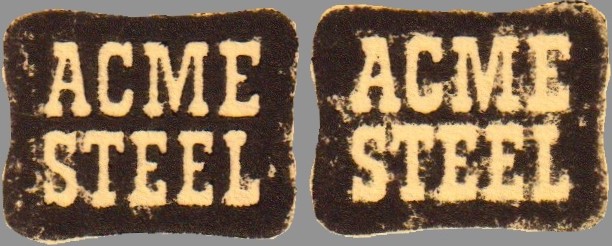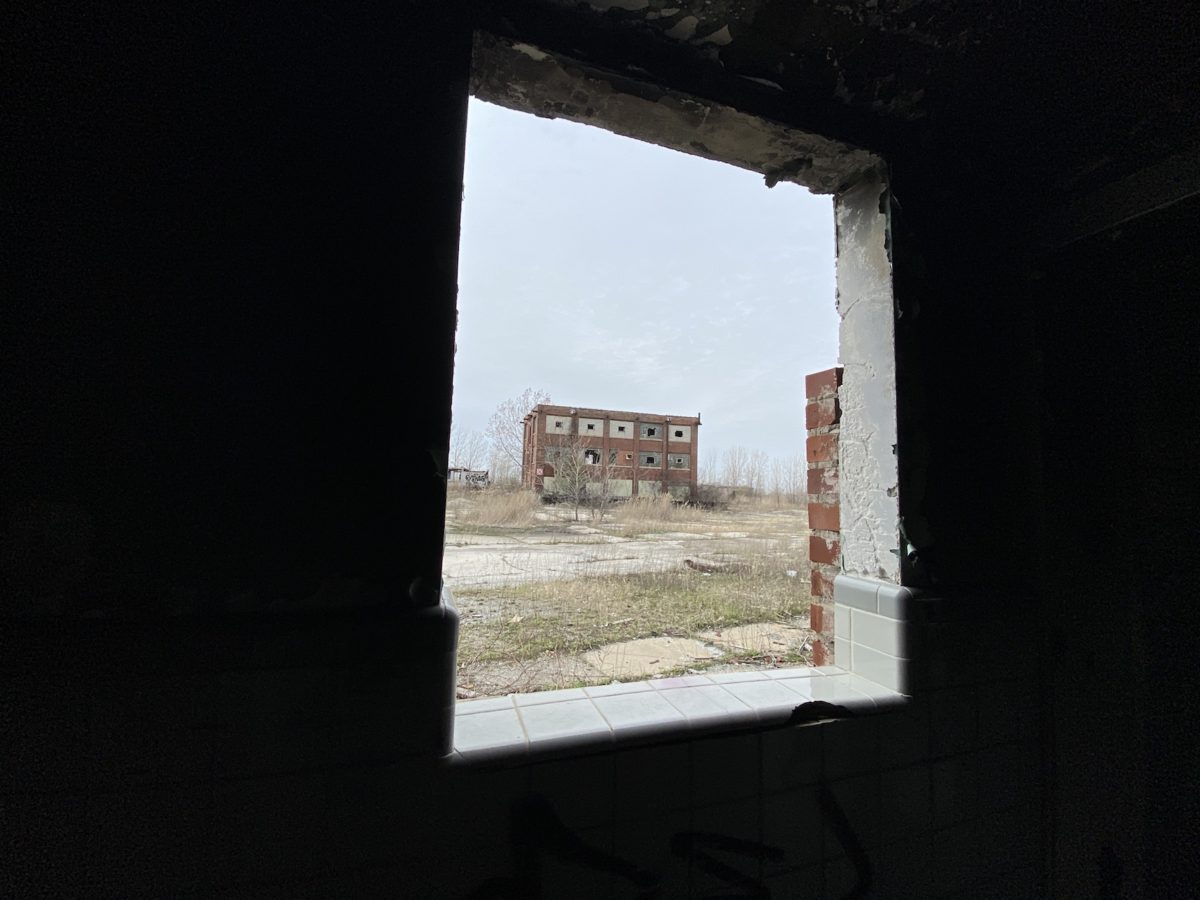Friday April 29th 2022 was a perfect day. Strong words, I know. I think many people would say they never have a perfect day. Others might say they have good days, but not perfect. And I have many bad days. But if you take a vacation day at work, you should hit the streets and go do the things you love to do. If you can’t wrap your arms around what those thing are, or around enough of them to fill a day….well, that must be rough.
I hoped my 40th visit to the plant would be a special one. But things started out as they often do. I took Pace bus #331 from my doorstep to the Cumberland Blue Line which I took to Washington. My initial plan was to walk to Millennium Station and take the South Shore Line to Hegewisch, then bike to the plant. But I never had a chance of making that train and I missed it by a few minutes despite my speed walking/jogging. This suddenly opened up a number of possibilities because I didn’t have a clear itinerary, or even care. I was happy to be hanging out at a train station my day off. I could take the Red Line to bus #71 as I have done numerous times before but that has grown dull. So I decided to take the Metra Electric line to South Chicago, where I could grab a Divvy and head straight to the plant. For on this day, I have a specific mission. But we will get to that.
I have taken the Metra Electric line a handful of times: to Kenwood or South Shore. This time I decided to take it to the end of the line at 93rd Street. This would leave about 3 miles to the plant. As I rode south, I glanced at the Divvy app and saw there were no e-bikes at the 93rd St. station. That won’t do at all – I am far too spoiled now to actively pedal my way to South Deering. I spotted an orphaned bike in an alley around 88th and Commercial, so I jumped off at the 87th St stop instead and headed over.
The bike was right where it should be and I was off! Protip: if you are approaching the plant from the north, you can always lock up a bike (Divvy or otherwise) to the wrought iron fence at 110th St (there is a sign post at 116th if you are coming from the south). I strolled into the plant and got to work.
It’s been a long time since I had any large scale document rescue to complete. The 2nd floor of the main office is pretty well cleaned out – and now access is all but impossible anyway. There are some documents in the north stairwell, but I’ve gone through those. However in my past few visits I started to notice some old memos floating around in the room on the east side of the building.
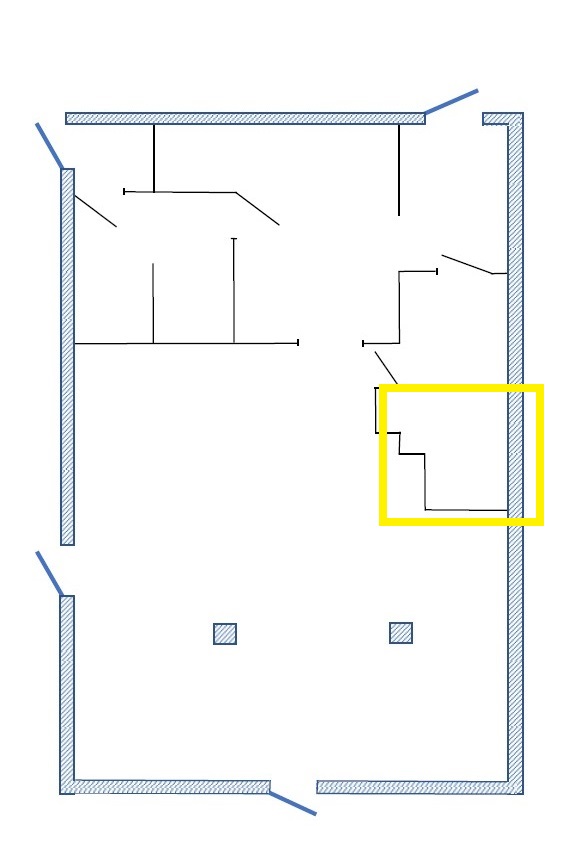
I had been grabbing what looked historically important on the past few visits and hiding them away for a future grab if I liked. The windows on the east side of the building are covered by huge corrugated plastic panels, I had stuffed a number of items into a manila folder and hidden it between the building and that panel in the room highlighted above. So I knew I wanted to grab that, but also to spend some time going through what was on the floor.
It was 90% memos, and I found not even one post-1979. I assume this was a single box which ruptured long ago. Before long I had a second equally fat folder to match my stash. I undertook this mission because I longed for the weekend evenings I enjoyed so many times in the winter of 2020-2021: sitting on the floor, hands black with coke/coal dust, having a few drinks and pouring over stacks of documents. I am desperate to have something to go through and while my standards have relaxed I do not wish to cart around garbage. But I do not consider internal memos dating back to 1951 garbage! Surely I have many of this ilk in my archive already but could a few more hurt?
I don’t have plans to scan any (most?) of these. I won’t even laminate them or put them in a binder. Many of them are the ‘onion skin’ type of paper common at the time and they are very fragile, but only as fragile as they ever were. Apparently sitting loose in an abandonded building for 20 years (after sitting in boxes for another 30-50 years) is a good form of preservation. So last night I just brushed away any loose dirt/dust, organized and collated them (by year) and then put them under a weight (a stack of vinyl LPs) over night. Now they are good as new! So let’s have a look.
1950-1959
The oldest document I found dates June 5 1951. It is a short memo from RB Chamberlain (asst. superintendent, by my research) to his boss, Harry Nicklaus. It is signed in ink (copies of memos abound).
One notable exchange covers five memos (6 total pages) over nearly two years. Each memo has the same subject line “Request for an additional Chemist in the Laboratory”. They were all written by KJ Purcell to his boss (HR Nicklaus). The first memo has hand written notes in pencil at the bottom stating “After consultation with CP Johnson, RB Chamberlain and C Parry it is decided an additional chemist is not needed”. But this did not slow Mr. Purcell as he continued to plead his case for the next 24 months. The next memo (exactly two weeks later) is two pages long and gives a detailed assessment of the current chemist’s responsibilities as well as a breakdown of the overtime worked by the current staff. I’m guessing this garnered exactly zero response because 18 months later, KJ Purcell – far from throwing in the towel – not only asked AGAIN but even referenced the previous memo as if it was yesterday!

Less than a week later – the pressure increased with a memo that introduces itself in the first sentence with “As a supplement to my letter to you of January 19th…” What tenacity! Silence for 6 months then another memo outlining the laboratory workforce going all the way back to 1942! Imagine having to pour over those records, no doubt handwritten. The memo closes with “…still more help will be needed when the new battery of ovens is put into operation”. No doubt this is true – and that would come to pass in only about a year. Handwritten notes at the bottom of the memo (dated one day later) state: “Hire one chemist to replace Wright. Hire one more chemist to have one extra chemist – total 9 chemists”. Success at last!
The only external memo for this decade comes in 1958, in a letter to the plant from Wilputte. This is replete with Wilputte letterhead and their New York address. This is hand signed in ink. Surely the relationship with Wilputte started a few years before battery #1 went live in 1956; this letter outlines some R&D on using weak liquor (plant produced ammonia) to remove moisture from tar (a historic problem).
We close the decade with again Mr. Purcell badgering his boss for more resources in the lab. This time it wasn’t manpower that was needed – it was equipment. The first of two memos dated 4/21/58 is a request for a new analytical balance (a scale for measuring mass). Apparently the current one (purchased in 1943!) was broken. When sent in for repairs, the plant was told it was not salvagable. So Mr. Purcell is requesting funds to buy a new one for $395 (almost $4000 today). But in his typical style, he closes the memo by mentioning there is another one also available for what would be almost $9000 in 2022! Not surprising in the note at the bottom of the memo:

It is almost too much to accept that yes, Mr. Purcell followed up THREE HUNDRED AND SIXTY SEVEN DAYS LATER! Mr. Nicklaus should have been delighted that he was allowed this two day grace period for follow up. This time. Mr. Purcell states that they desperately need this new equipment and that of the two remaining functional units one is circa 1934! The hand written notes at the bottom are from Mr. Nicklaus himself, stating “Instructed Purcell to requisition Ainsworth balance no. 5-2637…est. cost about $380.00”. A second page of legal paper is attached, this one from Reggie Chamberlain, dated one day previous to the hand written notes, state the same info: clearly Mr. Nicklaus delegated the research on a new balance to his second in command, lest they allow Mr. Purcell to select one himself for some wildly expensive cost! What is really interesting is that this second set of documents from 1959 I actually already had stashed away. As I reviewed these last night, then discussions on a new balance sounded very familiar. I located the document quickly, I took it home sometime ago because it was interesting but never laminated it.
1960-1969
The oldest document is from 9/26/60. It is a very brief memo from the head of purchasing (likely a position in Toledo, not on Torrence Ave) to HR Nicklaus saying ‘see attached’: a quote (from a company at 93rd and Ewing, I would cycle right by there on the way home a couple hours later!) for repairs to wash oil tanks. I don’t know if these repairs were ever undertaken, as the quote itself is from 1956, for some reason Mr. Nicklaus must have wanted to review the cost or details. The next memo is from about a year later, stating ‘Please obtain authority for us to close to following appropriation’: the purchase of two used wash oil tanks. I presume the two events are connected. This second memo is notable because Roger Nagan is in CC – he would be plant superintendent in the future and must have held some lesser position at the time. I note that in a memo from 1961, HR Nicklaus is referred to as assistant superintendant, a position previously held by RB Chamberlain. I suppose Reggie was now gone and perhaps Roger Nagan had taken over? Don Garthus would later also be an asst. super; a memo dated 1969 was penned by him regarding liquor oil quality. As the 60s progressed the old guard was disappearing, and new names were popping up.
The documents from 1970-1979 showed less which was notable. But I also grabbed a few other interesting things.
- A blueprint for the ‘pushing control system’ aka HKC duct shows a logo for the company’s author: Hartung, Kuhn and Co.. It is dated 2/23/78. I have a number of other documents on this system. It was inspected for potential repairs in 1997 – that report included two prints as well, this will be a nice addition.
- A brief analysis of a 24 hour chart for final cooler flow will make a nice addition to my research on these charts.
- A three page handwritten accident investigation from 1978 is a backing document to the typed version I already have.
- Some documentation the sewer alarm system – I already have some stuff on this but never did anything with it, these supplementary documents might bring it all together
- I found a lengthy document dated 1974 proposing a coal testing laboratory at the coke plant. After some searching, I found that I had located a copy (with corrections in red pencil!) previously – I knew it looked familiar!
- I found a large print: “Benzol Plant – Light Oil Equipment Modification to L.O. Drain System”. I don’t know that I will get this scanned but it will go into my physical archive with the many others.
- I found a couple menus in the coal handling office a few months ago and added them to my hidden stash. Now I have brought them home. Taco Mex still stands at the same address as it apparently has for many years. Chicago Al’s is gone – the tiny shack is currently La Cabanita, where I have been a couple times (note: I have a couple other old menus I found in the gate house scanned as well, if you are into that sort of thing).
This standalone document however just speaks for itself:

When I got done scooping up my documents, I just did my standard ‘wander around’ journey. I didn’t bother heading down to ovens, first I headed over to my office (the lunch room in the electric shop). I did some cleaning there, I found a large piece of broken plexiglass so I used it as a shovel to remove all the dirt and debris from the room. Looking good!
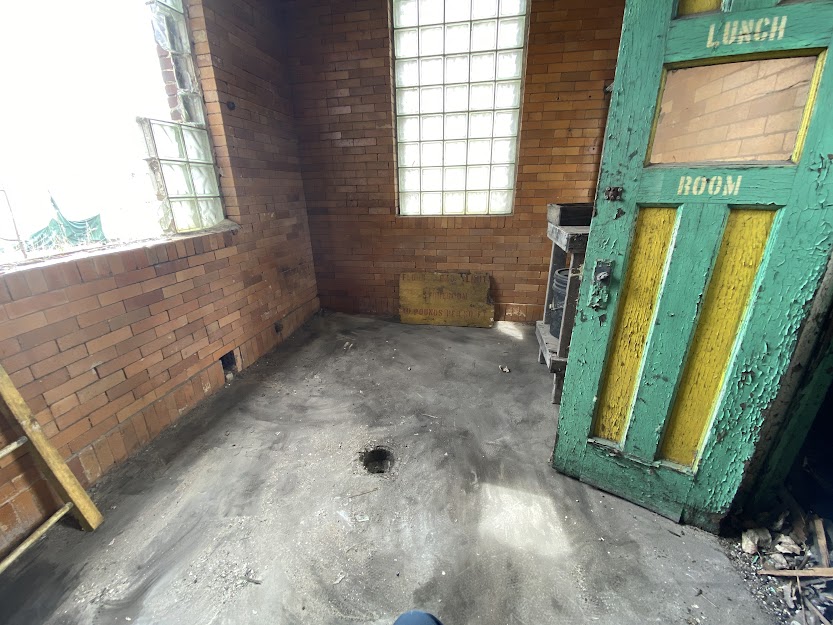
After that I headed over to the gatehouse. I took some photos looking west through the windows. Some came out more exciting than others.


I headed upstairs, quite aimlessly. At the landing half way up the staircase, I poked into the hidden room at the north end of the building. It seems to me that many years ago this was a useful room, then at some point it was framed off to never be used again. Then of course post-2001 some enterprising explorers smashed through the flimsy paneling to see what was inside (answer: nothing). Of course I have stuck my head in here before. Why I did again on this day I have no idea, but I am certainly glad I did.
I turned on the weak flashlight on my phone and beamed it around the room. I saw something in the corner. I have to assume this has been here all along, but I really don’t know. What I found was insane!

When I found them, I couldn’t even make out what the first two said. I knew there was a ‘danger’ heading but they were so filthy you couldn’t read a word. Scary that I have been in the plant so many times I knew that there was an old pair of jeans on the top floor. So I went up there and spread my loot out on the floor and started cleaning them off.
The first sign is the most notable. You don’t have to be an expert to know that there is no iron at a coke plant. That would be like having cake at a flour mill. The coke is an ingredient IN the iron! This sign is certainly from the blast furnace – but this begs many questions.
- The furnace plant closed shortly after the coke plant. But unlike the coke plant, it was razed just a few years later. So whoever grabbed it had to have done it 15 years ago or more.
- How/why did they carry it way over here?
- Has it been sitting in here for 15 years plus? Or maybe it was stashed elsewhere at the plant and someone moved them for a new safe keeping spot?

The ‘arc welding’ sign is notable because it actually has welding spatter on it! At first I thought it was some kind of corrosion but it is actual weld! So that sign was no joke – someone was not only welding nearby, but practically next to it!
The ‘visitors parking’ sign is the least important. I would assume (hope) that it was taken from the west side of the gatehouse, as this is where I presume visitors would park. But the CLUI photos from 2004 do not show any such sign. It’s possible our mystery man had already removed it but that seems silly as the other four signs in the photo would be far more valuable!
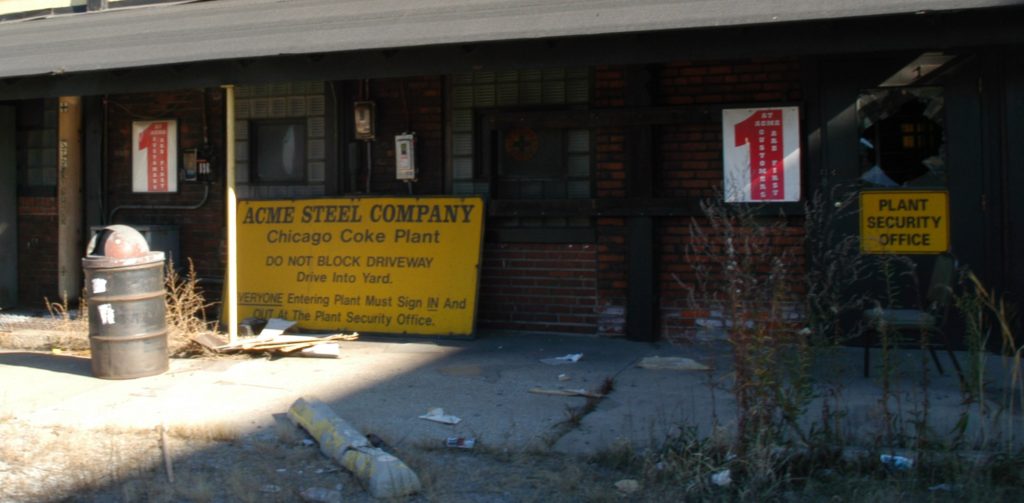
Finally content that I had more than enough scores for one day, I walked back to 110th to grab my bike. I headed to Hegewisch to grab a burrito at Los Cantaritos, then went over to Wesolek Park to devour it. I would have headed to Mann Park (better seating, picnic tables) because it was also on my way back north, but I did not want to take Torrence north. Instead I took the Burnham Trail to 106th (school had just let out so I had to decline the last leg up to 100th). I headed up Ewing to 93rd and wandered back to the train station.
It was a couple hours before I’d get home after a long wait at Union Station for a MD-W train. Walking 6 miles, cycling about 13 and 16 flights of stairs was enough for me. I only made it through about 3 drinks before I called it a night and got the best sleep in about a week.
